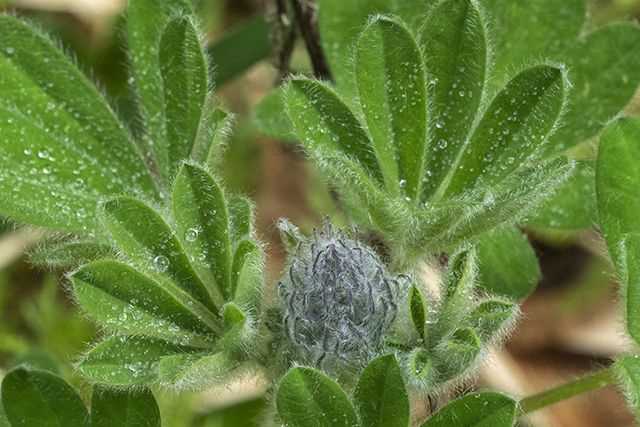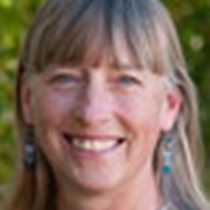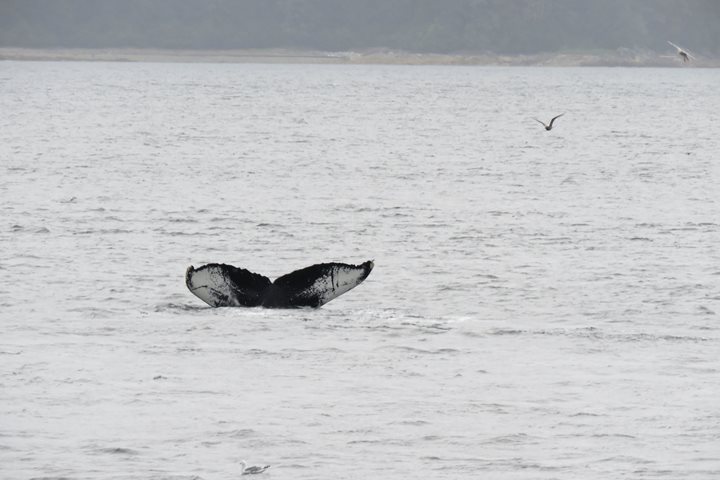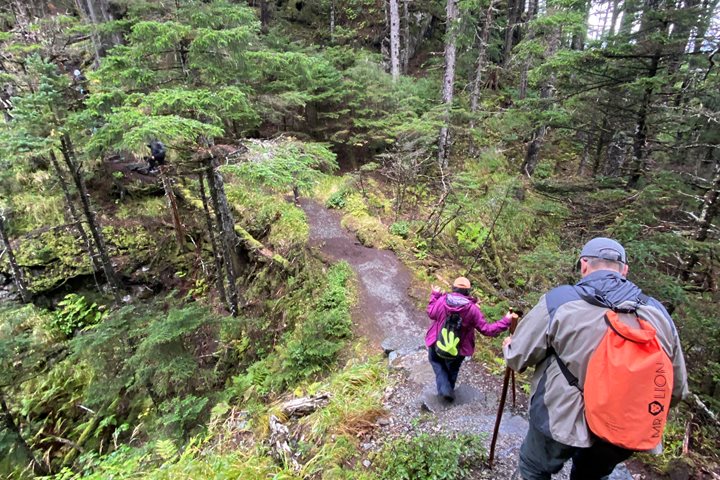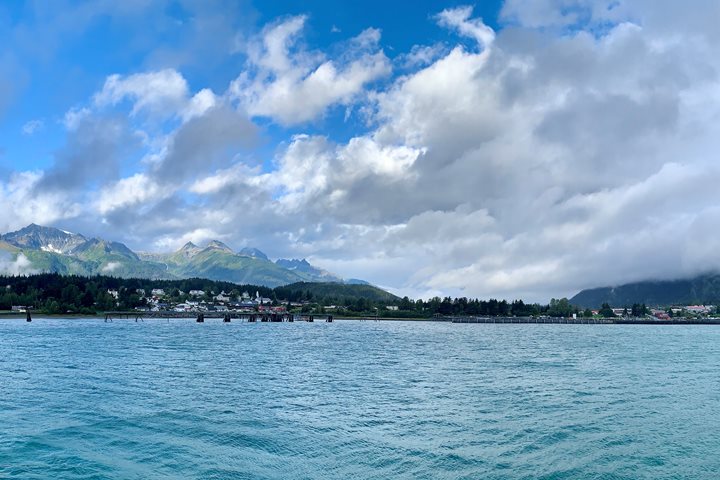We sailed into Mud Bay in the morning under broken clouds that revealed lovely blue skies. Waters were calm and reflective, and in the near distance we saw sea otters and humpback whales. Our plans for the morning included kayaking and exploring along the shoreline, the beach, and deeper into the forest. At the edge of the high tide line and the beach grasses, we discovered chocolate lilies about to bloom, beach strawberry plants with their delicate blossoms, and the fresh green of cow parsnip, silver fern, oak fern and more. We also found fresh evidence of a bear and followed a natural bear trail just inside the forest edge, where we studied fungi and giant lupine. Others chose to go on a moderate hike deeper into the forest, where they found a meadow and a stream. After lunch, we sailed towards the Inian Islands, anchoring in the Hobbit Hole, and took the expedition landing crafts out to cruise through the islands. The sun shined through breaks in the clouds, lighting up the edge of the islands. Here at the western edge of Icy Strait, the flood tide from the open sea meets the outflow of the Inside Passage and Icy Strait, creating an upwelling that pushes food closer to the surface, making it easier for the animals to feed. It’s a favorite place for sea otters, sea lions, humpbacks, eagles, and other birds. We saw Steller sea lions catching fish, thrashing them back and forth to break off bite-sized pieces, as hungry gulls hung close by for scraps. We observed a pelagic cormorant rookery, sea otters preening as they flowed along with the currents, many bald eagles in treetops and their nests. One group got a closer look at a humpback whale as it arched its back and dove, showing its fluke. All in all, it was a fantastic day of great activity.
9/5/2022
Read
National Geographic Sea Bird
Pavlof Harbor and Chatham Strait
Our final day aboard National Geographic Sea Bird began in Pavlof Harbor. The first coastal brown bear we sighted was a lone juvenile resting at the mouth of the stream, nestled amongst the rocks. We slowly headed to the falls to find a burly adult stalking salmon in the middle of the stream. As the season winds down, these bears are over double their spring weight. While they have been foraging all spring and summer on sages, grasses, berries, and more, the true calorie loading comes from their end of summer salmon feast. Every few minutes, this adult caught yet another salmon, only to gorge on the brains, eggs, and skin. The remaining bits are too muscly for the bears. Strolling along the edge of the stream after its nap, the juvenile joined in the salmon feast. While the adult patiently stalked its next salmon, the juvenile was less patient, often losing focus and staring around. It even appeared to avoid getting too wet by sitting, frog style, on a middle rock. A few minutes into our second round of bear sightings, we observed as a mother and two cubs approached! One quick swipe in the water, and this momma bear caught her first female salmon. She took a clean bite of the tail end, and out poured fresh salmon roe. The two cubs pushed in for a share of mom’s catch, each taking a chunk of the skin for themselves as well. While mom was willing to share, it seemed like one of the cubs was quite talented in the art of fishing. After a few tries, this new cub had already caught its first salmon. With a look to the right, the juvenile was still sitting above the rock, maybe afraid to intervene, or perhaps less of a hunter. Either way, the bear sat, still looking around and waiting for an easy target. We began this week with glacier carved fjords, stunning and close views of glaciers, and moments with marine mammals. We completed our journey at the stream along with the salmon. They come here to spawn and die, and their nutrients are recycled into the forest and animals around us. With such documentary worthy moments captured in our memories and in our photos, we headed back to the ship with an overwhelming sense of awe. I know that you are probably thinking nothing could make this day any better. Alas, this is Lindblad, and during the afternoon, we cruised the area in search of humpback whales. A few hours into our search, we found a relatively fast group of bubble-net feeding whales. With their surface feeding visible from the bow, naturalists and guests alike were shouting for joy. Later in the evening, we identified four of the six whales we sighted, learning that most of them have been sighted migrating to Hawaii for the winter. The evening closed with one final recap, our guest slide show, and conversations into the twilight. I could not think of a better send off from our time here in Southeast Alaska. Until next time! Photo caption: Visiting Pavlof Harbor and Chatham Strait.

